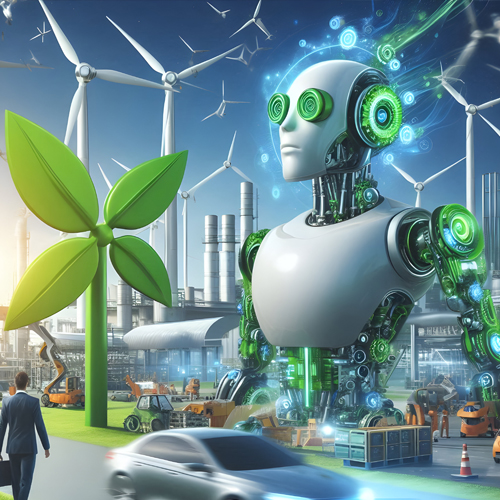
The Power of AI: Revolutionizing the Energy Industry
In the rapidly evolving world of energy, artificial intelligence is a game-
changer.
In the rapidly evolving world of energy, artificial intelligence is a game-changer. The energy industry is on the brink of a major transformation, powered by the capabilities of Artificial Intelligence (AI). In an era where sustainability, efficiency, and cost-effectiveness are crucial, AI is driving innovation like never before. From optimizing energy consumption to predicting maintenance needs, AI is reshaping the way energy is produced, distributed, and consumed.
In this blog, we explore how AI is not just enhancing the power sector but is also laying the groundwork for a smarter, greener, and more efficient future. Whether you’re part of an energy firm, a tech developer, or simply interested in the future of the energy landscape, understanding AI’s role in this transformation is critical.
Understanding the Role of AI in the Energy Industry
AI is revolutionizing the energy sector by enabling smarter decision-making, operational efficiency, and sustainability. Key applications include:
Data Analytics:
AI processes large datasets to provide valuable insights, improving forecasting and operational decisions.
Predictive Maintenance:
AI predicts equipment failures, allowing for timely maintenance and reducing downtime.
Energy Consumption Optimization:
AI helps optimize energy use by analyzing consumption patterns in real time.
Grid Management:
AI enhances grid stability by dynamically balancing supply and demand, especially with renewable sources.
Energy Storage:
AI improves the efficiency of energy storage by managing battery systems and predicting energy needs.
In essence, AI is helping the energy industry operate more efficiently, reduce costs, and deliver sustainable solutions.
AI’s Transformative Role in the Energy Sector
AI is revolutionizing the energy industry by optimizing processes and enhancing efficiency across various sectors. Here’s how:
AI helps integrate renewable energy sources like wind and solar into the grid by predicting energy output, ensuring a stable and efficient energy supply despite intermittency.
2. Smart Grid Management
AI-driven smart grids manage energy distribution in real-time, optimizing supply and demand to enhance grid stability and reduce energy waste.
3. Predictive Maintenance
AI anticipates equipment failures, minimizing downtime and reducing maintenance costs by enabling proactive repairs and extending asset life.
4. Energy Efficiency in Buildings
AI analyzes energy usage patterns in buildings and adjusts systems like HVAC and lighting, optimizing energy consumption and reducing waste.
5. Demand Response & Energy Trading
AI helps manage demand response programs and optimize energy trading by analyzing consumption patterns and predicting market trends.
Key Trends and Developments in AI for the Energy Sector
AI’s impact on the energy industry continues to accelerate, and key trends are emerging that are revolutionizing operations:
AI-Driven Predictive Maintenance:
With AI algorithms, companies can now predict equipment failure before it happens, reducing downtime and preventing costly repairs.
Smart Grids and Demand Forecasting:
AI-powered smart grids are optimizing energy distribution and balancing supply and demand in real-time, making the energy system more efficient and reliable.
Renewable Energy Integration:
AI is helping integrate renewable energy sources, such as solar and wind, by predicting energy output based on weather patterns, improving grid stability.
AI for Energy Storage Solutions:
AI is enhancing energy storage systems by optimizing battery usage, ensuring the effective storage and distribution of renewable energy.
These advancements are propelling the energy industry toward a more sustainable, efficient, and resilient future, making AI a cornerstone in transforming how energy is produced, managed, and consumed.
Key Business Advantages of AI in the Energy Sector
AI in the energy sector offers several advantages that drive efficiency, profitability, and sustainability:
Cost Reduction:
AI optimizes energy production, minimizes downtime through predictive maintenance, and automates processes, leading to significant cost savings.
Smarter Decision-Making:
AI analyzes data in real time, providing insights that help businesses make informed decisions, from energy mix optimization to grid maintenance scheduling.
Enhanced Sustainability:
By improving energy consumption forecasting, AI enables businesses to integrate renewable sources, reduce waste, and lower carbon emissions.
Scalability:
AI allows energy companies to scale operations without escalating costs by automating tasks and improving resource allocation.
Increased Reliability:
AI predicts and prevents grid disruptions, enhancing the energy supply’s reliability and resilience.
AI not only boosts innovation but also drives tangible business improvements, positioning energy companies for long-term success.
Effective AI Implementation in the Energy Sector: Best Practices
Implementing AI in the energy sector requires a strategic approach. Here are key best practices to ensure success:
Start by establishing clear, measurable goals. Whether optimizing energy consumption or enhancing predictive maintenance, a well-defined objective drives focus and success.
2 Prioritize Data Quality:
AI’s effectiveness depends on high-quality data. Ensure your datasets are accurate and complete, and invest in data cleansing to avoid inaccurate results.
3 Implement Gradually:
Begin with smaller, manageable pilot projects. Test and refine AI applications in targeted areas before scaling up to broader systems.
4 Partner with Experts:
Work with AI specialists who understand both the technology and the energy industry. Their guidance ensures the right solutions are applied effectively.
5 Ensure Scalability:
Select AI solutions that can grow with your business. Scalable systems ensure long-term effectiveness as your operations expand.
6 Monitor and Optimize Continuously:
AI isn’t a one-time fix. Regularly monitor performance and adjust the system based on new data and changing conditions.
7 Train Your Workforce:
Equip your employees with the skills needed to leverage AI effectively. Proper training fosters greater adoption and smooth integration into daily operations.
Following these best practices ensures a smooth AI adoption process, helping energy companies boost efficiency, reduce costs, and stay innovative.
Key Terms to Know
Artificial Intelligence (AI):
Machines simulating human intelligence to make decisions, solve problems, and learn from data.
Machine Learning (ML):
A subset of AI where systems improve automatically by learning from data without human input.
Predictive Maintenance:
Using data and AI to predict when equipment will fail, enabling proactive repairs and reducing downtime.
Smart Grid:
A digitally enhanced electrical grid that monitors and optimizes energy distribution using smart devices.
Energy Consumption Optimization:
AI-driven analysis of energy use patterns to suggest ways to reduce waste and increase efficiency.
Renewable Energy Integration:
The process of smoothly incorporating renewable sources like wind and solar into the power grid with AI’s help.
Deep Learning:
A branch of machine learning using complex neural networks to make advanced decisions and predictions.
Internet of Things (IoT):
A network of connected devices (like smart meters) that collect and share data to improve energy management.
Data Analytics:
The process of analyzing data to uncover insights, often to improve decision-making in energy management.
AI-Driven Automation:
The use of AI to automate tasks and processes, boosting efficiency across energy distribution and maintenance.
The Future of AI in the Energy Sector: What’s Next?
AI’s role in the energy sector will continue to evolve with advancements in predictive analytics, energy forecasting, and smart grid systems. Key future trends include:
Smarter Energy Forecasting:
AI will refine energy demand prediction, optimizing grid performance and energy distribution.
Decentralized Energy Systems:
AI will drive microgrids and local energy solutions, making energy use more efficient and autonomous.
AI-Powered Clean Energy:
AI will enhance renewable energy sources, making them more reliable and efficient.
Predictive Maintenance:
AI will reduce downtime and extend the lifespan of energy infrastructure with more precise maintenance.
Smart Cities:
AI will integrate into urban infrastructures, optimizing energy consumption and reducing waste.
As AI continues to advance, it will reshape the energy sector, driving sustainability and efficiency.
Embracing the Future of Energy with AI
AI is poised to be a driving force in transforming the energy industry, enhancing efficiency, sustainability, and resilience. By embracing AI, businesses in the energy sector can stay ahead of the curve, optimize operations, and contribute to a cleaner, smarter energy future.


